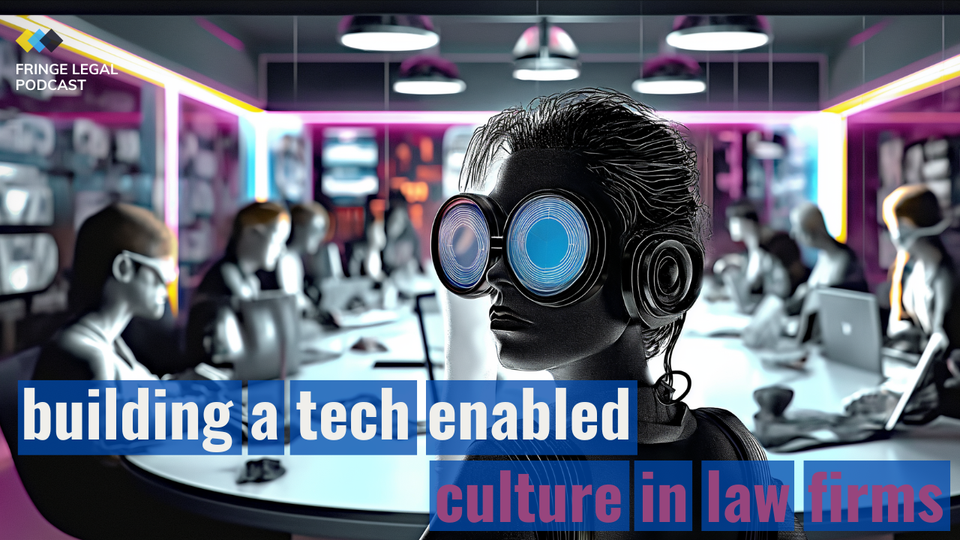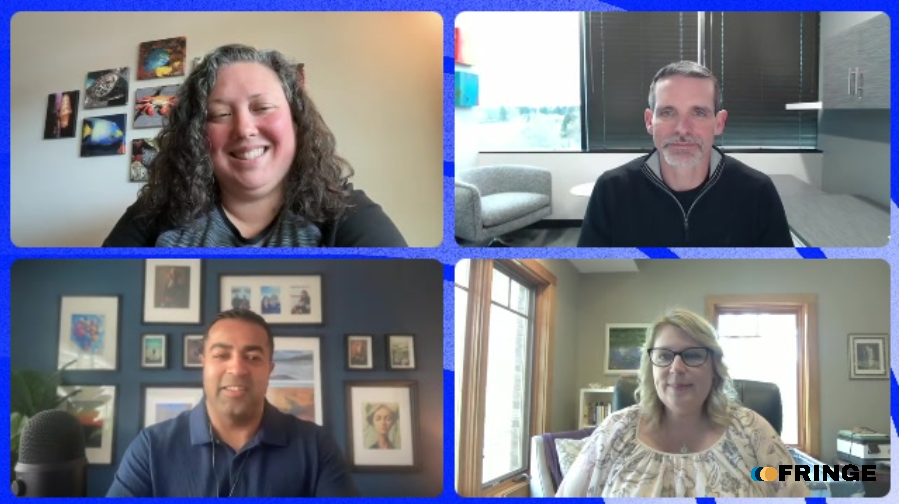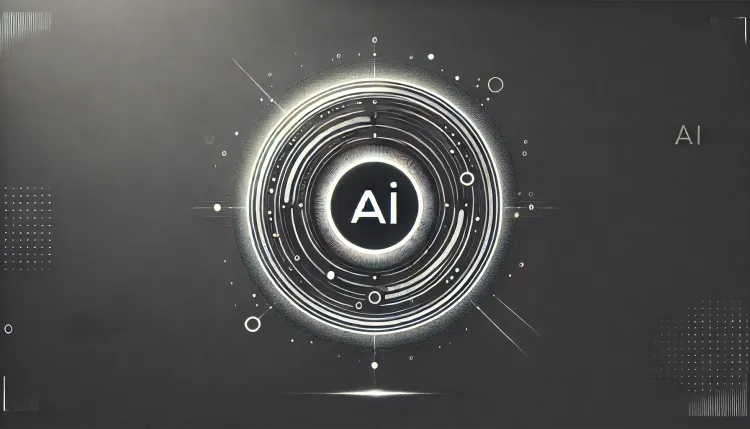Building a tech-enabled culture in law firms

In this episode of the Fringe Legal podcast, host Ab chats with Conan Hines, Director of Legal Technology at Fried Frank, about building a tech-enabled culture in law firms. Conan shares insights from his previous roles at Clifford Chance and other law firms, highlighting the importance of understanding the role of legal technology and the psychology and behavior of users when it comes to successful adoption and change management.
Conan emphasizes the need for building trust with lawyers and finding those who are curious and open to tech-enabled solutions. He suggests starting small with bite-sized engagements to build trust over time. He also discusses the value of creating a foundation for tech adoption and balancing short-term impact with long-term goals.
The conversation delves into the role of vendors in adoption, with Conan highlighting the need for a strong partnership and a transparent framework for success. He stresses the importance of vendors having a real adoption strategy and sharing learnings from what has worked in the past.
Ab and Conan also discuss the challenge of incentives and tracking adoption. They explore the idea of integrating technology training into legal training to emphasize the value and importance of tech skills for lawyers. Ultimately, the key to successful adoption and building a tech-enabled culture in law firms lies in trust, continuous communication, and demonstrating the value of technology.
Key takeaways:
- Building a tech-enabled culture requires understanding the role of legal technology and the psychology and behavior of users.
- Trust is essential for successful adoption. Lawyers need to believe that tech solutions can help them.
- Adoption plans should be simplified and tailored to individual users.
- Integration of technology training into legal training can help emphasize the value of tech skills for lawyers.
- Vendors should have a strong adoption strategy and share learnings from past successes.
Uncommon learning:
Tech adoption requires a partnership between law firms and vendors, with a focus on transparency and continuous communication.
Transcript
Below is the full transcript of the episode. It was generated and processed by AI, so that it is easy to read and follow.
[00:00:00] Introduction and Guest Background
Ab: Hello and welcome to the Fringe Legal podcast. I am delighted to have Conan Hines on the show today. Conan is the Director of Legal Technology at Fried Frank. He joined the firm recently, just a couple of weeks ago, and I'm excited to have this conversation.
Building a Tech-Enabled Culture in Law Firms
Ab: Conan and I spoke, and we kept coming back to this topic of adoption, of building a tech-enabled culture, especially within a law firm. So we are going to dive deep into that. But Kernan, thanks for joining me today.
Conan Hines: Thanks for having me. Good to be here.
Ab: So you've just joined the firm. Before this, you were at Clifford Chance, and before that, you were at another AmLaw 100 firm. So you've been going from one large firm to the next.
Understanding the Role of Legal Technology
Ab: Tell us a little bit about your current role and I guess the focus of your previous role. We won't go through and look through your entire history, but the last two roles would be helpful.
Conan Hines: Let's refrain from that because I don't want to show how old I am. We will start at Clifford Chance. I think what CC was head of the market on was bringing the technology groups into the innovation spectrum and not just saying, "Oh, we have it involved," but really putting in front-end business analyst-minded folks who were focused on understanding not just what the lawyers were doing, but becoming experts in the technology and working hand-in-hand to find that adoption, that inflection point. So that was great because I didn't have to focus a ton on the tech stack. We had a really good one at CC. It was focused on the psychology of the lawyer, the constraints of the lawyer, the opportunities, and how to build relationships. I valued those six years at CC. With Fried Frank, hopefully, I'm helping the great work that's already going on and [00:02:00] bringing some of the principles that I've learned and the tools that I think have worked into that work stream. But I will also now be more responsible for the tech stack and working on the vendor management side. So that will be new. And I'll also be working to build out an R&D function as well. Of course, right now that'll be heavily focused on gen AI, but it'll be more than that. I'm sure we'll dive into that as well today.
Adoption and Building a Tech Culture
Ab: Let's start with the adoption and building that culture and across both of the roles, you mentioned a couple of the key components there. So there's, of course, the technology, the tech stack, and it could be what you have already, and it certainly will be at some point. What do you need to add or subtract as the case might be? Sometimes, then there is the psychology and the behavior of the users because of course, that's the core thing that drives adoption and drives long-term change. Yeah, we'll touch on the R&D function because I think that's an interesting segue. There are certainly many approaches to that. As you think about the users and the technology today.
Identifying Gaps and User Engagement
Ab: What's your approach in identifying what's needed? How do you figure out, is what we have at the firm now, is that enough? Is that good enough? How do you identify the gaps and how do you actually bring the users, and I'll call them end users as a generalization, but it could be the attorneys, it could be anyone else who's gonna use the technology, how do you bring them into the fold? So they give you the feedback so they tell you, "This is what we need; this is what will be helpful," or frankly, "This is a problem that we would like you to solve." Because as easy as some of those things sound, in theory, it's actually really difficult, at least in my experience, to get that answer from people. You go and ask them, "How are things going? Do you have specific problems?" And you either hear crickets or no, or you get pretty bad answers sometimes, which are incomplete and very high-level for you to act on.
Building Trust and Implementing Change
Conan Hines: I wish I knew the answer to this. And we're definitely talking about ideas here and still looking for those silver bullet solutions.
Conan Hines: But I would say in the nicest way, it is brute force. You gotta be really nosy. I think it's not gonna work for everybody. So you find those that are curious enough and you start very small and with bite-sized engagements that start to build over time. My observation is that lawyers will give you time if they believe that there's a good chance you can help them. I think a lot of the times they don't believe there's a good chance you can help them. So that's what you have to overcome, and this will be a challenge in my current role, is how quickly do I want to make a tangible, noticeable impact versus building a foundation, which I think is more than a 90-day, 180-day remit. It's gonna take years and time to build that network. So you find the right people who are interested in that. Start with the business services, talk to people, learn about who the personalities are, build that social graph within your firm. Take that and start having conversations with those people. Look, it's a balancing act. You're gonna have projects that are going full throttle and they're gonna stop, and you're gonna need to pick up something else. So it's very difficult to manage all the different initiatives while staying at full capacity but not over capacity. Once you've built some trust with your lawyers, you can move forward with them. I think you need it at all levels. Some of it is you get lucky with those you invested time with who are gonna stay at the firm. That can be a little deflating when you've spent time with someone who's moving up the ranks and now they've left for another opportunity. When lawyers start, I talk to them about being the best legal mind. That's what you're trying to be. You work at firms like Fried Frank and the like. You are there to be a high-performing lawyer, but it's gonna take a long time to get there. One thing you can do is utilize technology to give yourself a more meaningful seat at the table. You can be a trusted advisor to more senior lawyers who really don't have as much knowledge about the tech and probably aren't doing as much of the work that the tech is going to impact. There's workstreams typically more on the junior to managing associate level. So trying to just be in their face, give them good programming, give them good content, be there, be available, and just prove yourself in that manner. Once you've proven yourself, I've found that you will have repeat customers and you will get more and more time with those repeat customers to really learn the ins and outs of what they do and then be able to deliver ultimately those solutions they want.
Ab: You covered it well there, which is so much of this comes down to trust. Of course, you have to find those curious people. Of course, you have to figure out where you can get those quick wins or have bite-sized engagements and have your team that can support that as well. But ultimately, in order for people to give up their time, you do have to propose something that they believe is meaningful and then they have to trust that you are the person who's gonna come and deliver and actually take it to the end or take the information they give you and do something with it. It reminded me of something from the Walter Isaacson book about Jeff Bezos. There was a point about trust there. The way you build trust is by just doing the hard things over and over again, and you get a reputation from that. And it's that simple. I'm paraphrasing that, but is that how you think about it? And I'm asking you because of course you are brand new to the firm, a couple of weeks old. You certainly have a reputation in the market and people will see, okay, this person's coming over from cc, great. That will buy you some credibility. But until you start doing something they don't know, is that your approach with, with the attorneys, with your team? Because of course you'll have to build trust with your team and everyone else that you're working with. And I wonder, there are no easy answers or silver bullets here for sure, but I wonder how you think about that as you're new in this role. And I think you touched on having this sort of 30, 60, 90-day plans, and they're helpful. But there's a lot of this start with just you having a ton of conversations as you touched on, how building that social graph. Just, listening to people and trying to figure out what's going on.
Conan Hines: Yeah, I'm going through my thought process on this podcast. It's kind of funny, so I doubt any Fried Frank lawyers are gonna listen to this, but maybe they can get a little bit inside my head as I think about how to get inside theirs. So there's some 3D chess going on, but actually, it's not very complicated, right? It's finding those who are authentic and somebody who's "in it to win it." And the one thing that I can say, and that a lot of people can say that are in my similar shoes is that I didn't just jump into this one day. It's been a long journey, and it's been intentional. I couldn't predict the gen AI wave. It's a boon to what people like me and yourself do, but it was bigger than that, right? It knew that it was, we had a data problem, right? And technology was getting better. And so this is a place to be that it was as simple as that. And then just doing whatever it took to get to the place I am now. That's what I think your colleagues are going to respect, right? They need to know that you're really in it for the right reasons. So your track record can speak to that and just the optics, for example, I don't know if this is a big thing, but our office is casual dress. Me, I won't wear casual dress in the office because I am, first of all, I don't have a lot of cool hip clothes. I just look like a homeless person in my hoodie if I walked in. But it's also just like I'm showing up because this is really important. It's all optics, right? Do you do what you say you were gonna do? Do you show up, and do you not show up if the people you're working with aren't doing what they're going to do and build demand for yourself? So that's what I try to do early. It's, hey, I am in demand. These services are in demand. First, hopefully, get more investment for what I'm trying to do from the firm, but also flip it on its head when I started at CC. It, there was no demand, right? So we had to build that demand. By the time I left, we were picking the projects and the people we wanted to work with, and we were setting the tone. And that's, I think there's some of that going on at Fried Frank, but I'm in no commodity. So that's the mindset I go into it with.
The Role of Vendors in Adoption
Conan Hines: From your perspective, Ab, on the vendor side, right? One thing I think is there's a partnership for adoption and you're not absolved from being on the law firm side from being well-versed in the tool you're trying to roll out. I think it's just a requirement for success at this. I've given vendors chances before, and a lot of times, they fall flat. And it's not that surprising because this is your firm. You know the people, you know the culture. Hopefully, you've broken down the process and understand how this fits in. The vendor is there to support the product that you're buying. But I also find that vendors, I across the board, are not coming with a real adoption strategy and real learnings from what has worked, which surprises me. I don't know if they don't share it or they really don't capture it, but I feel like that's the most helpful thing, showing that your tool has value. You get to a point where, of course, your tool makes sense. You're here; you've been here for years now. But how do people use it? I don't know how you approach that.
Ab: Yeah, it's a challenge for a number of reasons, and I'll share some of the ideas that we put into place that have worked. They may or may not work for everyone. Part of that is sometimes it is difficult to pinpoint the reason that it worked for customer A. And the reason I say that is we know what the tool is; we know how it works; I know the ins and outs of it, and we can deliver a training session. We can work with the technologists and trainers and anyone else to identify use cases and figure out how it works. But there usually is a part of the firm's process in 99% of the cases because most firms aren't that open. They'll invite the vendor to go and deliver a training session or two or three or speak to the attorneys, but it's very high level. It's at a group level. I think where you really figure out where why things are working is when you speak to that individual. If I can see that this person's been into the tool 10 times a day, spending hours in there, creating new matters, assigning tasks to people, I want to speak to them and figure out why. It's great; we'll celebrate and do a little happy dance, but I actually want to dig deep into that and figure out, okay, why are you doing that? And not the person who sits in the same office as you, who has access to the same tool. Why are they only going in there once a week? Is it just because you have more work? Is it because you're just naturally inclined to use technology or something else? And I think that "something else" is if you can find the answer to that. But most firms won't allow you to speak to the lawyers that much, and they don't want to go and ask them the question. They don't want to be a bother. But part of it is you gotta break through that barrier. We're happy not to be the bad guy as such, but we're happy to go ask that question because sometimes having an outside party asking you that question just produces better results and different results. You ask a lot of your users, I'm sure. And a lot of it starts over time, falling on deaf ears. It's the same reason when we do training internally for the tools we use. We can ask the same question as the vendor that we're working with, but a lot of the times the vendor gets the more complete answer because this isn't someone that you're going to see and spend time with every single day.
Ab: It's the same reason people open up so much to a stranger on a podcast or somewhere else, then they roll with people that they're going to work with very closely. So I think that's part of it. The way we do that is we come with either a lot of ideas or we will just share the stories. We'll anonymize them; I'll give my personal view, which is I know the product really well; I know why it should work, and I have lots of opinions on the right way of doing it. And I can tell you 10 different scenarios based on different practices or types of users on how you should implement it. What I don't know is your users, how they learn, what the culture is inside the firm, and maybe they just absolutely hate sitting through demos. That's just a thing that they don't like doing because they've sat through too many demos or whatever the case might be. So we'll come to you and we'll give you an alternative. Let us share 30- to 60-second clips that are useful for just-in-time learning. And I think most of the time, honestly, even if people have adoption plans. They need to be simplified. No one wants to sit through a 60-minute training session, no matter how much they like the tool, right? Give them something simple with a clear ask. Do this one thing during the training or straight after that, so they can put the learning into practice. And the second thing, which has been a big unlock, is you just have to do it over and over again, right? It needs to be either just-in-time, as much as you can make it happen, or it needs to be continual because I've learned many products and I use them, and then sometimes I don't need to use them for another three months, and then I come back and I'm like, I wish I remembered what I needed to do here, how this worked. So you just need to be that sort of constant reminder. If you have this kind of work, there's something available to you because it's too easy for people to just go back into what they're trained in doing, what they've been doing for the last X amount of years, the status quo for you. And you have to keep reminding them. There is a different way, a better way, to what you're doing. Just try it. And usually, for us, it takes three, four times before it becomes something that they will naturally come to. But you need to be that person that's nagging them a little bit, over and over again, so you're hoping that you get them that one time when they're most needed. Oh, actually, this came at the best time. Now I will go and do this. I don't know if that helps.
Conan Hines: No, I agree. Adoption plans should be simplified, and it's not a one-size-fits-all. I just think it is a critical deliverable that is a partnership between the vendor and the innovation person.
Ab: And when you think about adoption plans, what's your preference, or what have you seen that's worked? Have you seen, because I've seen adoption plans that are, here's an adoption plan that goes for six months. I've also seen adoption plans that say, this is what we are going to do to get you up and running. And then after that, let's have a check-in every quarter or something like that.
Conan Hines: It's like you said, getting down to the individual user. That in a lot of ways is ideal and you get a lot of rich insights from that, but it's intense, right? It takes a lot of effort to do that, especially you can't really do it at scale in a larger firm. For most plans, don't go, unfortunately. Some things pick up faster, a lot of times maybe they linger longer. I think you have to assess the willingness of the teams. Are the same people still in place that were there when you were evaluating the tool and getting all that sorted? So that'll be a new challenge for me to see how we evaluate their usage once we have tools in place. Are we getting the value out of them? Is it an adoption problem and the tool can work for us? Or is it a technology problem and the tool really isn't working how we had hoped it to be and then make decisions from there. But I think you should have something transparent. You should have a framework. We're building that out further right now. There's something in place; we're gonna make it even clearer, simple to understand and welcome for people to engage in. I think we're small enough now that if you just get your people who keep coming back, you'll be successful from there once you've created that demand threshold.
Ab: Yeah. Yeah. And what I've seen work quite well is you have your problem statement, this is what we're trying to provide a solution for, and actually attach to that, which is the thing that gets left out most frequently. This is what it would look like if we get this right. This is the outcome. I say that because the outcome isn't always, we have everyone using the product. It could be that we wanted to figure out a better way to run deals, and this is what the outcome looks like. Our deal cycle goes from 16 weeks to 12 weeks. Great. That may not be because every single person is using the tool, but you have the critical person who was the bottleneck before using the tool, and now you're getting the right outcomes. So having that, what does, how do we know that we got this right? as a question is important. Then you have the framework on how are we going to adopt this, and hopefully, you're working with the vendor to do that. And they can provide a lot of the expertise, they can provide a lot of the knowledge, example, and resources to actually make it happen. I. Then you have the actual going through the motions and getting people incentivized to use this. Because I think there is that incentive point. I know you and I discussed this in a chat before, which you need to find the incentive, right? What's that, what's that Charlie Munger quote that, you show me the incentives, and I'll tell you what the outcome will be. I think that is so important, and a lot of the time it's not there, but tied to that, it's tracking the data, the behaviors, and everything else. And it could be the usage of the tool because we're talking about technology. It could be the ROI calculation that you need at the end for a business case, or it could be something completely different. Maybe the ROI isn't there from a true time-saving perspective, but you're reducing the stress. Maybe you are giving people a better work-life balance or something else, which is important and part of a retention calculation. But I think those things do make a difference. And I guess, out, out of those, love to take your take on incentives. How do you think about the incentives? How do you that drive the right behaviors? Because not every behavior may be the right behavior.
Conan Hines: Yeah, there's not a direct incentive like a performance-based incentive really at most firms. And even the ones who try to implement that, I think, are difficult to oversee and maintain. Again, where the light bulb went off was that technology is typically trained in a different channel, right? If you just think back to psychology, I'm coming in, I'm an associate, I have legal trainings I need to attend. So that means one thing to me. I also have to do these other trainings, right? Like probably like how to do expenses and how to do the technology training, right? These are separate trainings. They're viewed differently. If they had a bucket of focus tokens, they would put more of their focus on the legal trainings, right? That's what you are as a lawyer. So one thing that I've done, and we'll do more going forward, is syncing all of that programming into one channel. So the technology training is the legal training. So now the optics are saying this is paramount to you becoming a successful lawyer. It's not just "I need to know these things" but "I need to do things differently." This is something that the more senior and seasoned lawyers can't really train you on effectively because they themselves are not practicing that way. So it's really invoking a new class of legal professionals that will join forces and amplify that legal training while keeping the optics alive. So you do that, and I think subliminally, but also in the front of consciousness, it will be something that will stick with the lawyers, and it will show credibility when someone like myself is coming to you and asking you to test this tool on your deals and coming with honestly the knowledge of those deals. Being able to go into someone's practice and understand what they do is a lot easier to start a conversation when you're like, "Hey, I'm really interested in tech and by legal tech, but what is even the basic things that you do?" And it's hard to start from that point because by the time you get to the problem, the lawyer has to go back and start billing again probably. Yeah. It's hard. It's really hard. It's stacked up against us, but I think that tide will change soon as things come to a reckoning.
Ab: Yeah, and I think for law firms, it is challenging because as many of the individuals will have billing targets, they have other focus areas. And at least what I'm seeing, which is fantastic, that there are mavericks within the firms that are championing innovation, doing things in a slightly different way. I think what the challenge for the profession as a whole, not any one firm, is how do you work with them? And there's the pushing and pulling where on one side, it's trying to say, "Look, just be focused on your role. Just be a lawyer, whatever that means," and there are other firms, which is what I would like to see more of, who instead of resisting that innovation and I don't mean innovation in the sense of technology, always, but innovation in the sense of doing things in a different way, which is sometimes leveraging tech and sometimes it's a process and sometimes it's something else. They symbolize it, they go through and say, "Yes, this is how we do this right. Let's put this person and show them as an example that you can think outside the box and you can win, and we will reward that behavior by recognizing you and saying that this is one way to go." Not to say that everyone should do that; it's always has to be the case, but I think there needs to be some sort of recognition and/or reward for just drawing outside the box every now and then because that's how you expand the box a little bit. And I think in your role, certainly, maybe you are that maverick. I don't know. We'll find out. We'll chat again in a year's time and see how things have gone.
Conan Hines: Maybe, I'm certainly crazy, I think sometimes for what we set out to do when everything is stacked up against us. But at the end of the day, for me, you've gotta have some fun with it. I think another way to attract people who are gonna be with you is to show that this is also just not another business-as-usual thing that you're bolting on. We're gonna have fun; we're gonna be a little silly. We're gonna make it inviting to those who just want to come in and do things that are gonna take some time to get used to, and like I've said, really, R&D happens in the live deal in a law firm. There isn't really this lab; we're not set up to have that and incubate it and then bring it out to market. You gotta try it on the fly. So if you don't keep it a little light and you don't think about how you're delivering your message, then you're not gonna be doing the best job that you can. So I would just ask the audience to think about that a bit.
Ab: Yeah. I think that's a good time to start wrapping up. You are new in the role, but I'm sure we'll be hearing a lot of updates as you learn more and as you put things into practice. If people want to reach out, I'll include Conan's LinkedIn so you can connect with him and I'm sure he would welcome the connection and any support or questions that you might have for him as well. But yeah, this was a really good conversation. I know we touched on a lot of difficult topics, and we probably don't have any clear answers, but hopefully this inspires people and gives them a perspective into how we think about different ways of approaching problems. I appreciate your time and looking forward to staying in touch and seeing how the role develops.
Conan Hines: Awesome. Likewise, Ab. Thanks for having me.
Ab: Thanks.






Become a Fringe Legal member
Sign in or become a Fringe Legal member to read and leave comments.
Just enter your email below to get a log in link.